The A6 Years Part I
'A' for Alfieri and '6' for the number of cylinders.
"... built for road and race, Sports Car and Formula 2".
The revival of sporting
activity in Italy after the second world war, as far as motor sport was concerned, was a rather
slow process. The road network was in desperate need of repair and the few permanent
circuits like Monza were reduced to a pitiful state. The few pre-war race cars
remaining were showing their years, in spite of the efforts of enthusiasts and owners who had
rescued them from the horrors of war. Understandably, energies and resources
were concentrated on activities of greater social and economic importance.
For obvious reasons the first races, mainly held on temporary circuits, were
more suited to 'sports cars' than the more costly and sophisticated single-seater race cars.
In 1946, however, the Italian Sport Commission undertook to organise motor sport by drawing up a
preliminary draft of regulations and subdivisions for the various classes. To simplify matters,
competitions after the war were grouped into three main classes: Touring, Sports Car and Grand
Prix (then divided in Formula 1 and 2). These were in turn categorised
depending on engine size and cars with supercharged engines were banned from the Touring and
Sports Car classes.
If Maserati initially threw its efforts towards sports cars it was because
of necessity rather than choice. In the years leading up to the war, plans were drafted for a
6-cyl normally aspirated 1.5-litre engine. This was derived directly from
that of the 6CM (with supercharger), the successful pre-war single-seater (1936-1939). In early
1946 the engine, known as the 'A6TR' ('Testa Riportata'), was first used in a 'Barchetta' - a
collaboration between Ernesto Maserati and engineer Alberto Massimino for a loyal customer, one
Guido Barbieri. The car became the model line for cars known as the A6, constructed in two types,
'touring' and 'race'. From this model line came the A6GCS, one of the great race cars of the
post-war era.
The Barchetta prototype, officially named the '6CS/46' but more commonly known
as the 'A6 Sport', had a rather short motor sport career. The same can be said of another model
constructed some months later and driven by 'Gigi' Villoresi in a few races without much success. However in 1947 Guido
Barbieri in an 'A6 Sport' won the Italian title in the 1500 cc class.
Ernesto Maserati, the now technical director for the 'Casa del Tridente',
decided that engine 'A6TR' was to power a production car, not a race car. At the 1947 Geneva
Motor Show, the A6 was unveiled as a two-door 'berlinetta', designed by Pinin Farina with
its modified 1488cc engine (the ignition and induction were simplified and it was eqipped with one
carburettor instead of three) now producing 65 bhp and a top speed of 150 km/h. The 'A6' heralded
Maserati's entry into the field of 'mass production' whilst still preserving its racing soul.
The A6 1500 (1946-1950)
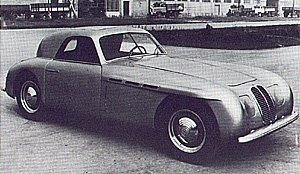
One of the first A6 1500s with coachwork by Pinin Farina
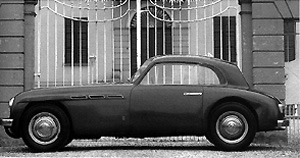
An A6 1500 with revised coachwork by Pinin Farina
| A6 Technical specification |
| Engine |
Front engined 6-cyl in line |
| Bore and stroke |
66mm x 72.5mm |
| Cubic capacity |
1488.2 cc |
| Compression ratio |
7.25:1 |
| Distribution |
OHC with 2 valves per cylinder @ 75° |
| Induction system |
Normally aspirated with No 1 Weber 36DCR
carburettor |
| Power output |
65bhp @ 4700 rpm |
| Ignition |
Single with Marelli ST95DAS distributor |
| Lubrication |
Forced by pressure pump |
| Cooling |
Water cooled forced by centrifugal pump |
| Gearbox and clutch |
4-speed and reverse - single dry
plate |
| Transmission |
Rear wheel drive |
| Chassis |
Tubular structure with longitudinal and cross
members |
| Front suspension |
Independent with coil springs and
Houdaille hydraulic shock absorbers |
| Rear suspension |
Rigid axle with coil springs and
Houdaille hydraulic shock absorbers |
| Steering |
Rack and pinion |
| Brakes |
Hydraulically operated drum brakes |
| Wheels |
Pressed steel 3.50 x 16 (Wire wheels
optional) |
| Tyres |
Pirelli 5.50 x 16 |
| Wheelbase |
2550 mm |
| Wheel track |
Front - 1274 mm and rear - 1251 mm |
| Dry weight |
Berlinetta from 780 - 950 kg - Spider 800
kg |
| Bodywork |
2-door Berlinetta and Spider 2+2 by Pinin
Farina |
| Overall dimensions |
Dependant on type of bodywork |
| Maximum speed |
150 kph / 94 mph |
The term 'mass production' is perhaps a little misleading as
every car at Maserati was practically hand-built. In fact Pinin Farina introduced a
new version with re-styled headlamps and an additional side window only a few months after the
debut of the 'A6'. At the 1948 Turin Show, a spyder version was finally launched, of which only
two examples were made of a total A6 production of 61 cars between 1947 and 1950.
Maserati's entry into 'mass production' didn't signal the end of
competition and sports car production. After all, Maserati's primary source of pre-war revenue
were its motor sport customers; a loyalty that Maserati were not about to
overlook. The real reason was to find an effective way of competing in the 'Sports car' category
which towards the end of 1947 culminated in the 'A6GCS', where 'G' stood for 'Ghisa'
(the cast iron cylinder block) and CS
its purpose 'Corsa and Sports-car'. Engine size was increased from 1.5 to 2-litres, and with an
increase in the compression ratio and the addition of two extra carburettors, power output was
almost doubled from 65bhp to 120bhp. However the most interesting technical innovations were to
be found in the body and chassis. The 'barchetta' configuration was abandoned and replaced with
the new fashion of the time, uncovered wheels with motorcycle type mudguards. For the first time
in a car of this type, the chassis was tubular and appreciably lower in weight (around 630kg).
Another peculiar characteristic of the 'A6GCS' was the position of its engine: slightly off the
centre-line towards the passenger side. This allowed the driver's seat, and therefore the centre
of gravity, to be lowered.
The A6GCS (1947-1953)
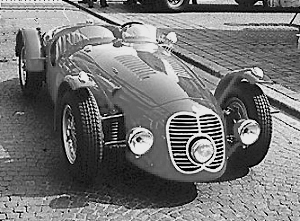
The Tipo A6GCS series 1 two-seater .
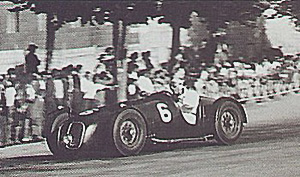
Luigi 'Gigi' Villoresi at the wheel of an A6GCS.
| A6GCS Technical specification |
| Engine |
Front engined 6-cylinder in line |
| Bore and stroke |
72mm x 81mm |
| Cubic capacity |
1979.7 cc |
| Compression ratio |
11:1 |
| Distribution |
OHC with 2 valves per cylinder @
71.5° |
| Induction system |
Normally aspirated with No 3 Weber
36DO4 carburettors |
| Power output |
120-130bhp @ 6000 rpm |
| Ignition |
Single with Marelli ST95DAS distributor |
| Lubrication |
Forced by pressure pump |
| Cooling |
Water cooled forced by centrifugal pump |
| Gearbox and clutch |
4-speed and reverse - single dry
plate |
| Transmission |
Rear wheel drive |
| Chassis |
Tubular structure with longitudinal and cross
members |
| Front suspension |
Independent with coil springs and
Houdaille hydraulic shock absorbers |
| Rear suspension |
Rigid axle with longitudinal leaf springs
and Houdaille hydraulic shock absorbers |
| Steering |
Rack and pinion |
| Brakes |
Hydraulically operated drum brakes
(diameter 290 mm) |
| Wheels |
Wire wheels front 3.50 x 16
and rear 3.50 x 15 |
| Tyres |
Pirelli front 5.50 x 16
and rear 5.50 x 15 |
| Wheelbase |
2310 mm |
| Wheel track |
Front - 1210 mm / Rear -
1150 mm |
| Dry weight |
Sportscar - 630 kg -
Race 580
kg |
| Bodywork |
2-seater Sportscar and
Race body
in aluminium by Medardo Fantuzzi |
| Overall dimensions |
Length - 3690 mm / Width -
1380 mm / Height - 900 mm |
| Maximum speed |
190-205 kph / 120-130 mph |
The first outing of the
'A6GCS' was at Modena on 28th September 1947, piloted by Villoresi and Alberto Ascari, a young
driver from Milan in the early stages of a distinguished career. The race was marred
by trajedy when the Delage of Giovanni Bracco lost control and careered into the
crowd, killing five spectators and injuring several others. The race was stopped and the new
Maseratis, which were leading at the time, were awarded first and second. This was a promising,
if somewhat fortunate, start for both the new Maserati and the young Ascari.
The development of the 'A6GCS' was made
possible by the racing activities of the semi-official teams of Scuderia Milan and Scuderia
Ambrosiana and the privateers in the 2-litre class soon to become Formula 2. In its early years
the 'A6GCS' achieved some significant successes, notably in 1948 when Giovanni Bracco won the
Italian Championship in the 2000 cc class. However, in the following years its fortunes
declined dramatically due in part to the strength of the opposition, notably Ferrari, but mainly
due to Maserati's serious financial situation, that in February 1949 caused the
temporary closure of the factory.
Total production of the 'A6GCS' between
1947 and 1953 was limited to 16 cars and of these only 5 were produced after 1950. These later cars, furnished with twin overhead camshaft engines, assume a greater importance as they can be
considered to have a direct link with the 'A6GCS/53'.
Maseratis new horizons
that had begun with the 'A6' were not totally forgotten and in 1951 a new model was introduced.
Called the 'A6G', even though the engine blocks were no longer in cast iron but in light
alloy, it was powered by the same 6-cyl 2-litre engine of the 'A6GCS', but did not possess its nervous temperament having been detuned by adjustments to the induction system and reduction of the compression ratio by decreasing the cubic capacity from 1979.7 cc to 1954.3 cc (its stroke was reduced by 1 mm).
The public's response was poor and the project proved unsuccessful for Maserati. The car was too expensive, especially for a car lacking a little in performance when compared to the 12-cylinder cars being produced not too far away at Maranello. Its saving grace being the elegant designs produced by the likes of Pinin Farina, Frua and Vignale.
The A6G (1951-1953)
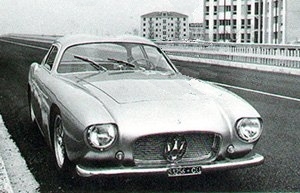
An A6G/54 with coachwork by Zagato
| A6G Technical specification |
| Engine |
Front engined 6-cyl in line |
| Bore and stroke |
72mm x 80mm |
| Cubic capacity |
1954.3 cc |
| Compression ratio |
7.8:1 |
| Distribution |
OHC with 2 valves per cylinder @ 71.5° |
| Induction system |
Normally aspirated with No 3 Weber 36DO4 carburettors or No 1 40DCR
carburettor |
| Power output |
100bhp @ 5500 rpm |
| Ignition |
Single with Marelli ST95DAS distributor |
| Lubrication |
Forced by pressure pump |
| Cooling |
Water cooled forced by centrifugal pump |
| Gearbox and clutch |
4-speed and reverse - single dry
plate |
| Transmission |
Rear wheel drive |
| Chassis |
Tubular structure with longitudinal and cross
members |
| Front suspension |
Independent with coil springs and
Houdaille hydraulic shock absorbers |
| Rear suspension |
Rigid axle with coil springs and
Houdaille hydraulic shock absorbers |
| Steering |
Rack and pinion |
| Brakes |
Hydraulically operated drum brakes |
| Wheels |
Pressed steel 3.50 x 16 (Wire wheels
optional) |
| Tyres |
Pirelli 5.50 x 16 |
| Wheelbase |
2550 mm |
| Wheel track |
Front - 1274 mm and rear - 1251 mm |
| Dry weight |
1100 kg
kg |
| Bodywork |
2-door Coupé and Spider 2+2 by Pinin
Farina, Frua, Bertone, Vignale, Zagato and Ghia |
| Overall dimensions |
Dependant on type of bodywork |
| Maximum speed |
160 kph / 100 mph |
|
To enter Enrico's Maserati Pages CLICK HERE!
Copyright: Enrico's Maserati Pages - © 2000-2005. All rights reserved. |

